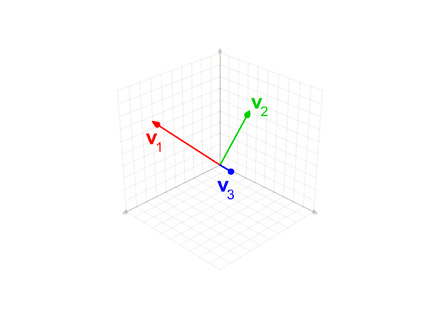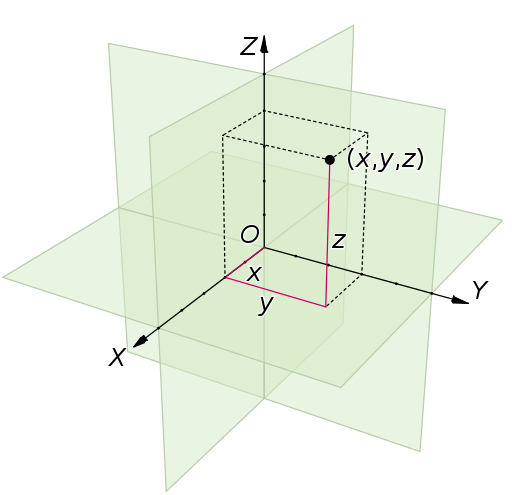공간벡터의 내적과 길이, 각도의 관계
$$ \vec{x}\cdot \vec{y} = \left| \vec{x} \right| \left| \vec{y} \right| \cos\theta $$
로부터 inner product space에서 두 vector 사이의 각도를 정의할 수 있다.
$$ \theta = \cos^{-1}{\frac{\left\langle \mathbf{x}, \mathbf{y} \right\rangle}{\sqrt{\left\langle \mathbf{x}, \mathbf{x} \right\rangle}\sqrt{\left\langle \mathbf{y}, \mathbf{y} \right\rangle}}} $$
공간벡터의 내적에서 두 공간 벡터 사이의 각도가 \(\frac{\pi}{2}\)(직각)인 경우 내적은 0이 되는데, 많은 계산에서 계산이 간단해지므로 좋은 도구가 된다. Inner product에서도 이에 대응되는 개념을 다음과 같이 정의한다.
Inner product space \(V\)의 vector \(\mathbf{x}\)와 \(\mathbf{y}\)가
$$ \left\langle \mathbf{x}, \mathbf{y} \right\rangle=0 $$
이면 \(\mathbf{x}\)와 \(\mathbf{y}\)는 orthogonal하다 고 부른다. Vector들의 집합 \(A\)에 대하여 임의의 vector \(\mathbf{x}\in A\)와 \(\mathbf{y}\in A\)가 항상 orthogonal한 경우 집합 \(A\)를 orthogonal set이라고 부른다. 만약 orthogonal set \(A\)의 모든 vector들이
$$ \left\langle \mathbf{x}, \mathbf{x} \right\rangle =1 $$
즉, norm이 1인 경우 집합 \(A\)를 orthonormal set이라고 부른다.
경우에 따라 두 vector들의 집합 \(A\)와 \(B\)가 서로 orthogonal하다는 표현을 쓰기도 하는데, 이는 임의의 vector \(\mathbf{x}\in A\)와 \(\mathbf{y}\in B\)가 항상 orthogonal하다는 것으로 이해하면 된다.
Inner product의 basis가 \(\{\mathbf{e}_i\}\)인 경우
$$ \mathbf{x}=\sum_i x_i \mathbf{e}_i $$
$$ \mathbf{y}=\sum_j y_j \mathbf{e}_j $$
의 inner product는 inner product의 linearity로부터
$$ \left\langle \mathbf{x}, \mathbf{y} \right\rangle=\sum_{i,j} x_i \overline{y}_j \left\langle \mathbf{e}_i, \mathbf{e}_j \right\rangle $$
가 된다. 만약 basis vector들 사이에
$$ \left\langle \mathbf{e}_i, \mathbf{e}_j \right\rangle=0 \mathrm{~for~} i\ne j $$
의 관계가 있다면
$$ \left\langle \mathbf{x}, \mathbf{y} \right\rangle=\sum_i x_i \overline{y}_i \left\langle \mathbf{e}_i, \mathbf{e}_i \right\rangle $$
로 inner product가 간단해진다. 여기에
$$ \left\langle \mathbf{e}_i, \mathbf{e}_i \right\rangle =1 $$
의 관계가 성립한다면
$$ \left\langle \mathbf{x}, \mathbf{y} \right\rangle = \sum_i x_i \overline{y}_i $$
가 된다. 즉, Basis를 orthonormal set으로 택하는 것은 inner product를 계산을 간단하게 해준다.
이러한 basis를 orthonormal basis라고 부른다.
Vector space \(V\)의 basis \(\mathcal{B}\)가 모든 \(i\), \(j\)에 대하여 basis vector \(\mathbf{e}_i\), \(\mathbf{e}_j \in \mathcal{B}\)가
$$ \left\langle \mathbf{e}_i, \mathbf{e}_j \right\rangle = \delta_{ij} $$
인 경우, 즉, \(\mathcal{B}\)가 orthonormal set인 경우 \(\mathcal{B}\)를 orthonormal basis라고 부른다.
예를 들어, Euclidean space \(\mathbb{C}^n\)의 standard basis
$$ \mathbf{e}_i = (0,\cdots,0,1,0,\cdots,0) $$
은 stamdard inner product에서 orthonormal basis이다. Orthogonality는 inner product로부터 정의되므로 inner procuct가 달라지면 orthogonality도 달라진다. Orthonormal basis의 경우 vector를 basis로 전개했을 때 $(i$)번째 계수를 inner product로부터 쉽게 표현할 수 있다.
$$ x_i = \left\langle \mathbf{x}, \mathbf{e}_i \right\rangle $$
Gram-Schmidt Process
문제는 임의의 inner product space에서 언제나 orthonormal basis를 찾을 수 있는가 이다. 일단, Finite-dimensional inner product space의 경우 언제나 orthonormal basis를 찾을 수 있다. 하나의 basis로부터 새롭게 orthonormal basis를 얻어내는 방법 중 하나가 Gram-Schmidt process이다. Gram-Schmidt process의 핵심은 linearly independent한 두 vector \(\mathbf{x}\)와 \(\mathbf{y}\)으로 얻을 수 있는 vector
$$ \mathbf{y} - \frac{\left\langle \mathbf{x}, \mathbf{y} \right\rangle}{\left\langle \mathbf{x}, \mathbf{x} \right\rangle}\mathbf{x} $$
는 \(\mathbf{x}\)와 linearly independent하고
$$ \left\langle \mathbf{x}, \mathbf{y} - \frac{\left\langle \mathbf{x}, \mathbf{y} \right\rangle}{\left\langle \mathbf{x}, \mathbf{x} \right\rangle}\mathbf{x} \right\rangle=0 $$
즉, \(\mathbf{x}\)와 orthogonal 하다는 것이다.이를 이용하여 orthonormal하지 않은 basis
$$ \mathcal{B} = \{ \mathbf{e}_1,\mathbf{e}_2,\cdots,\mathbf{e}_n \} $$
에서
1. 첫 번째 vector를 아무 것이나 택한다.
$$ \mathbf{f}_1 = \mathbf{e}_1 $$
2. 두 번째 vector를 선택하여 첫 번째와 linearly independent하고 orthogonal한 새로운 vector를 얻는다.
$$ \mathbf{f}_2 = \mathbf{e}_2 - \frac{\left\langle \mathbf{f}_1, \mathbf{e}_2 \right\rangle}{\left\langle \mathbf{f}_1, \mathbf{f}_1 \right\rangle}\mathbf{f}_1 $$
3. 세 번째 벡터를 선택하여 첫 번째와 linearly independent하고 orthogonagl한 새로운 vector를 얻고 이를 이용해 다시 두 번째 vector와 linearly independent하고 orthogonal한 새로운 vector를 얻는다.
4. 이를 \(n\)번째 vector까지 반복한다.
5. 새로 얻은 \(n\)개의 vector의 norm을 1로 만들어 준다.
$$ \mathbf{g}_i = \frac{\mathbf{f}_i}{\sqrt{\left\langle \mathbf{f}_i,\mathbf{f}_i \right\rangle}} $$
이렇게 얻은 새로운 basis
$$ \mathcal{C}=\{ \mathbf{g}_1,\mathbf{g}_2,\cdots,\mathbf{g}_n \} $$
은 orthonormal set이다.
By Lucas V. Barbosa [Public domain], from Wikimedia Commons
Orthogonal Complement of Subspace
\(\mathbb{R}^3\)의 subspace인 xy-plane
$$ S=\{ (x,y,0) ~|~ x,y \in \mathbb{R} \} $$
에 대하여, 또다른 subspace인 z-axis
$$ P=\{ (0,0,z) ~|~ z \in \mathbb{R} \} $$
는 서로 직각이다.
By Jorge Stolfi [Public domain], from Wikimedia Commons
\(S\)와 \(P\)는 서로 직각이기 때문에 그들의 vector 역시 직각이다. 즉, vector \(\vec{v}\in S\), \(\vec{w}\in P\)가
$$ \vec{v} \cdot \vec{w} = 0 $$
이다. 또한 \(S+P=\mathbb{R}^3\)이고, \(S\cap P = \{(0,0,0)\}\)이므로
$$ \mathbb{R}^3 = S \oplus P $$
이다. 이렇게 subspace와 직각인 나머지 모든 부분을 모은 집합을 일반화하여 orthogonal complement라고 한다.
Inner product space \(V\)의 subspace \(W\)에 대하여, 집합
$$ W^\perp = \{ \mathbf{v}\in V ~|~ \left\langle \mathbf{v},\mathbf{w} \right\rangle=0 \mathrm{~~for~all~}\mathbf{w}\in W \} $$
를 \(W\)의 orthogonal Complement라고 한다.
3-dimensional Euclidean space와 같이, Subspace \(W\)와 \(W^\perp\)는 \(V\)의 direct sum이 된다.
Inner product space \(V\)와 \(V\)의 subspace \(W\)에 대하여,
$$ V=W \oplus W^\perp $$
\(\mathbb{R}^3\)의 예제의 경우
$$ \left( S^\perp \right) ^\perp = P^\perp = S $$
가 된다. 일반적으로 finite dimensional inner product space의 경우
$$ \left( W^\perp \right) ^\perp = W $$
가 성립한다. 그러나 infinite dimensional inner product space의 경우 \(\left( W^\perp \right)^\perp \ne W\)일 수 있다.
'Mathematics > 선형대수' 카테고리의 다른 글
| (선형대수학) 4.6 Isometry, Unitary Operator (1) | 2018.08.02 |
|---|---|
| (선형대수학) 4.5 Self-adjoint Operators(Hermitian Operators) (1) | 2018.08.02 |
| (선형대수학) 4.4 Hermitian Adjoint of Operators (0) | 2018.08.02 |
| (선형대수학) 4.2 Norm (0) | 2018.08.01 |
| (선형대수학) 4.1 Inner Product Space (0) | 2018.08.01 |
| (선형대수학) 3.8 Jordan Normal Form (0) | 2018.08.01 |

